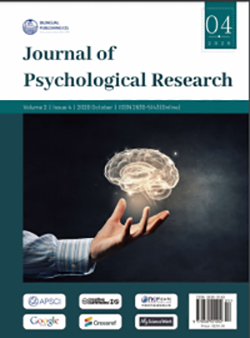-
1541
-
1345
-
1336
-
1329
-
1205
Effects of Color on the Buildup and Resolution of Proactive Interference in Working Memory
DOI:
https://doi.org/10.30564/jpr.v2i4.2388Abstract
The “color superiority effect” was confirmed by the research of color on forgetting, which showed that proactive interference (PI) has less impact on colored items than gray ones. Color could directly affect the buildup of PI, leading to reduced levels of interference, or controlled processes that resolve PI. However, the effects of red and green on memory were inconsistent. Using Recent-Probes task, the current study explored how the red and green color influenced to the buildup phase (i.e., 200ms after the onset of probe) and resolution phase (i.e. 800ms after the onset of probe) of PI. Results revealed that the reaction times of green words were significantly shorter than the red words under 200ms. There were no significant differences between the red and green words under 500ms and 800ms. It indicated that green might shortened the reaction times for the PI buildup, while red prolonged it. However, on the resolution phase of PI, green words were less effective than red words. These findings offered some new information for the underlying mechanisms that modulate the interactions between color and memory.
Keywords:
Color, Proactive interference, Buildup and resolution phase, Working memoryReferences
[1] Bredart, S., Cornet, A., Rakic, J. Recognition memory for colored and black-and-white scenes in normal and color deficient observers, PLoS One, 2014, 9(5): 98757-98757.
[2] Spence, I., Wong, P., Rusan, M., Rastegar, N. How color enhances visual memory for natural scenes, Psychol. Sci., 2006, 17(1): 1-6.
[3] Wichmann, F. A., Sharpe, L. T., and Gegenfurtner, K. R. The contributions of color to recognition memory for natural scenes, J. Exp. Psychol.-Learn. Mem. Cogn., 2002, 28(3): 509-520.
[4] Mammarella, N., Di Domenico, A., Palumbo, R., Fairfield, B. When green is positive and red is negative: Aging and the influence of color on emotional memories, Psychol. Aging, 2016, 31(8): 914-926.
[5] Kuhbandner, C., Spitzer, B., Lichtenfeld, S., Pekrun, R. Differential binding of colors to objects in memory: Red and yellow stick better than blue and green, Front. Psychol., 2015, 6.
[6] Bunting,and Michael. Proactive interference and item similarity in. working memory, J Exp Psychol Learn Mem Cogn., 2006, 32(2): 183-196.
[7] Cyr, M., Nee, D. E., Nelson, E., Senger, T., et, al. Effects of proactive interference on non-verbal working memory. Cogn. Process, 2017, 18(1): 1-12.
[8] Öztekin, I., McElree, B. Relationship between measures of working memory capacity and t h e t i m e course of short-term memory retrieval and interference resolution, J. Exp. Psychol. Learn. Mem. Cogn., 2010, 36(2): 383-397.
[9] Mizrak, E., Oztekin, I. Relationship between emotion and forgetting. Emotion, 2016, 16(1): 33-42.
[10] Otani, H., Libkuman, T. M., Goernert, P. N., Kato, K., Migita, M., Freehafer, S. E., Landow, M. P. Emotion, directed forgetting, and source memory, Br. J. Psychol., 2012, 103(3): 343-358.
[11] Kuhbandner, C., Pekrun, R. Joint effects of emotion and color on memory, Emotion, 2013, 13(3): 375- 379.
[12] Travis, D. Effective color displays: Theory and practice. London, UK: Academic Press, 1991.
[13] Briki, W., Hue, O. How red, blue, and green are affectively judged, Appl. Cogn. Psychol., 2016, 30(2): 301-304.
[14] Elliot, A. J., Aarts, H. Perception of the color red enhances the force and velocity of motor output, Emotion, 2011, 11: 445- 449.
[15] Jonides, J., Nee, D. E. Brain mechanisms of proactive interference in working memory, Neuroscience, 2006, 139(1): 181-193.
[16] Monsell S. Recency, immediate recognition, and reaction time, Cogn. Psychol., 1978, 10: 465-501.
[17] Loosli, S., Rahm, B., Unterrainer, J., Weiller, C., Kaller, C. Developmental change in p r o a c t i v e interference across the life span: Evidence from two working memory tasks, Dev. Psychol., 2014, 50(4): 1060-1072.
[18] Büchner, Vanessa L, Maier, M. A. Not always a matter of context: direct effects of red on arousal but context-dependent moderations on valence, Peer J, 2016, 4(9).
[19] Levens, S. M., Phelps, E. A. Emotion processing effects on interference resolution in working memory, Emotion, 2008, 8: 267-280.
[20] Kaller, C. P., Loosli, S. V., Rahm, B. et, al. Working memory in schizophrenia: Behavioral and neural evidence for reduced susceptibility to item-specific proactive interference, Biol. Psychiatry, 2014, 76(6): 486-494.
[21] Hartshorne, J. Visual working memory capacity and proactive interference, PLoS One, 2008, 3(7): 2716- 2716.
[22] Roberson, D., Davidoff, J., Davies, I. R., Shapiro, L. R. Color categories: Evidence for the cultural relativity hypothesis, Cogn. Psychol., 2005, 50: 378-411.




 Rong Liu
Rong Liu





